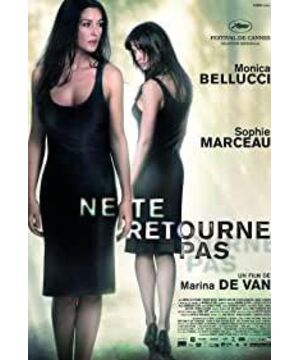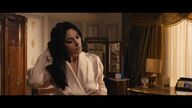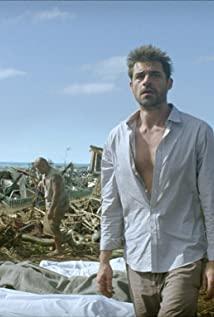The rookie French film director Marina de Von dedicated us a film that is not easy to understand. The audience needs to understand the feelings of the protagonist from the perspective of a mentally ill person. Because the picture is composed of the three elements of the protagonist Yana’s real life, imaginary space and memories, the director Marina de Wang did not separate the three elements, and did not produce multi-line development, but completely through the actor Sophie. The distortion of Marceau's face is transformed into the actor Monica Bellucci, which makes the three elements precisely unite, making the audience confused.
In fact, if we calm down and watch this movie carefully, it is not difficult to find the director's film idea. At the beginning of the story, the protagonist Yana is still a normal person. We know that her profession is a female writer. She has a husband Taio who loves her and two lovely children. Her emotional variation follows her. It started with the Italian blonde woman in the mother's picture. From then on, she began to imagine herself as that woman, and that she was her, when in fact, that woman was her biological mother. The story tells that the heroine Yana went from mental illness to schizophrenia. She never realized she was mentally ill, and finally gradually adapted to real life. Sophie Marceau’s Yana (actually Rosa Maria) suffered a car accident when she was eight years old and lost her childhood memories. She lives with her adoptive mother, who has always regarded her as the dead girl Yana. However, she vaguely retains incomplete memories deep in her heart. Therefore, she often thinks about the characters in the photos. There is often a girl on the lens. In fact, that is her imaginary world. There are many shots. It is the imagination and memories of the heroine, and this is why many viewers cannot understand it. At the end of the film, the protagonist becomes a schizophrenic. It is no longer the protagonist's facial distortion that turns into Monica, but Monica and Sophie face each other. This shows that the protagonist already knows that he is a mentally ill patient and has begun to adapt to it. The film ends in tragedy. It seems that Yana has returned to normal, but in fact, she just compromised her mental pressure.
There is an ancient legend in France. When a person is dying, if you hold another person’s hand tightly, the soul will enter another person’s body. In this film, when a car accident occurs, the hands of Yana and Rosa are Held tightly together. According to this legend, Maria de Wang was deeply influenced by the films of Bunuel and Pasolini, and created a story about the eternal soul that the Chinese did not believe. The two women were playmates when they were young. Yana, played by Sophie Marceau, died in a car accident when she was a child. Her mother regarded Rosa Maria, played by Monica Bellucci, as her daughter to raise her up. , And Rosa Maria’s parents thought it was their child who died. Under the influence of Yana's mother and her own psychological factors, Rosa Maria gradually entered the role of Yana, lost herself, but brought things from her original life into Yana's life, such as her eyes Neither her mother nor her husband are real, but merely images of childhood. Under the dual pressure of work and life, she was unbearable and insisted on finding herself. The dual identity also made her exhausted and the family was difficult to maintain. In the end, she found out the truth, found herself back, and returned to the family. Yana and Rosa Maria have never been separated in spirit. Now Yana admires Rosa Maria’s family life. When Rosa creates, the two souls create together, just like playing together when they were young. Playful. Rosa Maria always has hallucinations in her life. She doesn’t know who she is, Rosa Maria or Yana. The environment at home is not consistent with the impression in her mind. She doubts the authenticity of the photos. Husband There are also two images (the image of Yana’s brother in fantasy). Later, when I returned to my mother's house, I saw a picture of three people, two little girls and a blond young woman. She asked who the black hair was. Her mother said she was when she was young, but Rosa Maria didn't believe it, thinking that the blonde girl was when she was a child, and the blonde mother was her biological mother. Rosa Maria returned to Italy to find her, and she also found her lost memories at the prom. While looking in the mirror, Rosa Maria dreamed of changing back to her childhood, making phone calls with her mother in the morning, just like her childhood. Finally, she took the train back to France. After coming back, she dressed herself as an imaginary adult Yana for the last time, and finally recovered her true self under the call of her mother from her daughter.
The concept of this "Mo Looking Back" can also be summarized by the name "Skin" of Marina de Von's previous work: Two middle-aged women with completely different looks and identities, the French Yana "hidden" in the Italian. In Rosa Marina's "skin", the process from sleep to awakening. Yana, a female writer with a happy life and a happy family, suddenly undergoes tremendous changes in her body when faced with a creative dilemma. Not only his physical appearance, but also the surroundings of his relatives and surroundings are all erased, which is so weird and unclear. The heroine has to go back to the memories and lead the audience to find the reasons. Everything starts from the memories, and what is lost in the memories is the past of her childhood. The confusion in the film turned into a weird suspense, and the time-space relationship was completely disorganized. Yana was plunged into a surreal fog, and the audience followed in circles, only to discover the director's intention, like watching a face-changing magic show.
"Mo Looking Back" uses advanced computer special effects to simulate each stage of Sophie Marceau's gradual transformation into Monica Bellucci. Moreover, this change must always be accompanied by the development of the plot, rather than a shot that can be completed in a few seconds. In the film for more than ten minutes, Yana’s face is half Sophie, half Monica, and two beautiful women. 'S facial features are bluntly collaged on one face, becoming weird and ugly. Outsiders are not surprised by this completely unreasonable look. The changes in the heroine, the repeated changes in the characters and the environment have blurred the boundaries between reality and imagination. In the film, like many thrillers, the "psychological reappearance" method is adopted, and the audience sees only the illusion of the heroine. Including her own appearance, the appearance of her mother and husband, children, family background, etc. Yana must search from her childhood and birthplace, just like the hypnosis of a psychologist, to find herself from the depths of her memory. What "Mo Looking Back" does is to photograph this process. Subjective and objective are confused, reality and illusion are side by side, and the soul and the flesh are combined and separated.
This is a film unlike any other, the director disrupted the montage and narrative. The audience needs to figure out the causal logic by themselves and fill in the loopholes. This idea of searching for the secrets of family history is very similar to that of Almodóvar in the early days, especially the passage where Yana recognized her mother from the photo and went to southern Italy, which became the real turning point of this suspenseful story. Audiences familiar with this type of subject can already guess the origin of the matter, and gradually accept the director's approach, and then present it from a girl's perspective will feel logical. In contrast, Almodovar’s suspense is clear and neat, and he can create magical effects through dramatic techniques without magic special effects.
Sophie Marceau, who is no longer as exciting as Shishui Furong, has begun to hold the guide tube in recent years, but the response has been uneventful, and it is far less concerned than when she was an actress. Monica Bellucci frequently appeared in the American and French film circles, and also tried to break through the vase stereotype, and took several dramas that tested her acting skills, but the results were not satisfactory. What's interesting is that the director of "Don't Look Back", Marina de Von, is a "little talented girl" who has made great progress in the French film industry in recent years. She is not very young, but she was born in a science class at the French Higher National Vocational Academy of Video and Sound. Her image is also quite plastic. She often acts as a screenwriter or a role in the films of François Auzon and other brothers. Marina de. Wang is quite talented, an all-round filmmaker who can direct, write and act. "Looking Back" is Maria de Von's second feature film. The last debut film "Skin" has won wide acclaim in the circle and audiences. This time we will make persistent efforts as a newcomer and will be directly selected for the screening unit of the Cannes Film Festival. A top-notch beauty, on the same stage as the masters, she has a very promising future.
As a commercial film, the biggest selling point of the film is the co-starring of two top European beauties. In the film, since only a woman is changing, there are actually not many rivals. One person and half of the story are evenly distributed. Sophie Marceau plays the first half and Monica Bellucci plays the second half. There is only one stare at the end, which can be regarded as the completion of the "handover ceremony" of the soul to the body. As for whose acting skills are better, Sophie Marceau has more doubts and fears, and there are more and heavier roles to play. The mood of the audience is also mobilized with her psychological performance. By the time Monica Bellucci returned to Italy to search, the story was smooth and clear, supplemented by flashbacks of childhood memories, leaving less room for performance. What makes people talk about it is the process of Yana's face change. The reconstruction of facial features through 3D technology, the delicate makeup of the eyes and the bridge of the nose, let the audience see the most complete and detailed "face-changing magic" in the history of film.
Unfortunately, the evaluation of "Mo Looking Back" was not high after its release. It should be said that the audience is still very curious about such a suspenseful subject. It is not a flat and boring story. The alienation of the actor's body is itself an innovation. However, to evaluate "Mo Looking Back" as an art film, one will feel that the director and screenwriter are playing mystery and show off special effects. Regarding the film as a commercial film, it is unable to fully accept its expression methods and lacks a simple and understandable narrative logic. But it would be unfair to give the two actresses a comment alone. This is the first time that they have cooperated. In the years when the charm is still there, it takes courage to use this "breaking" duel method to leave a trace on the screen. This requires courage and is worthy of the fans' pursuit and obsession for many years. The story develops to Italy, Monica Bellucci seems to have a sense of comfort, especially in the scene where she dances, there is really a little girl's innocence and arrogance. After challenging various extreme roles, she has a warm and sensible femininity, especially when the two look at each other at both ends of the room, the two completely different temperaments complement each other.
View more about Don't Look Back reviews










